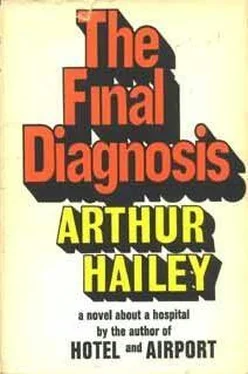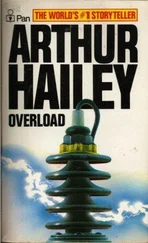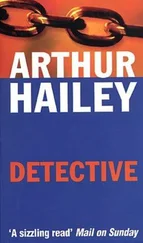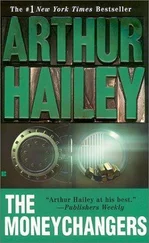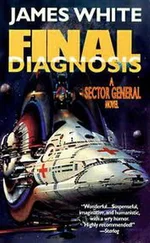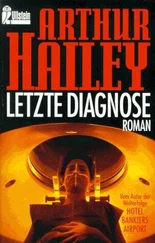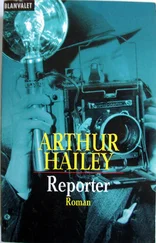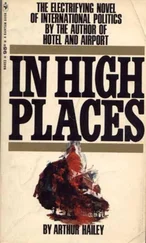Arthur Hailey - The Final Diagnosis
Здесь есть возможность читать онлайн «Arthur Hailey - The Final Diagnosis» весь текст электронной книги совершенно бесплатно (целиком полную версию без сокращений). В некоторых случаях можно слушать аудио, скачать через торрент в формате fb2 и присутствует краткое содержание. Жанр: Триллер, на английском языке. Описание произведения, (предисловие) а так же отзывы посетителей доступны на портале библиотеки ЛибКат.
- Название:The Final Diagnosis
- Автор:
- Жанр:
- Год:неизвестен
- ISBN:нет данных
- Рейтинг книги:4 / 5. Голосов: 1
-
Избранное:Добавить в избранное
- Отзывы:
-
Ваша оценка:
- 80
- 1
- 2
- 3
- 4
- 5
The Final Diagnosis: краткое содержание, описание и аннотация
Предлагаем к чтению аннотацию, описание, краткое содержание или предисловие (зависит от того, что написал сам автор книги «The Final Diagnosis»). Если вы не нашли необходимую информацию о книге — напишите в комментариях, мы постараемся отыскать её.
The Final Diagnosis — читать онлайн бесплатно полную книгу (весь текст) целиком
Ниже представлен текст книги, разбитый по страницам. Система сохранения места последней прочитанной страницы, позволяет с удобством читать онлайн бесплатно книгу «The Final Diagnosis», без необходимости каждый раз заново искать на чём Вы остановились. Поставьте закладку, и сможете в любой момент перейти на страницу, на которой закончили чтение.
Интервал:
Закладка:
“Are there never any exceptions?” The student nurse asking the questions seemed persistent. Pearson did not appear to object though. Maybe this is one of his patient days, McNeil thought. The old man had them occasionally.
“Yes, there are,” he was saying. “Before we can do any autopsy we must have permission from the family of the deceased. Sometimes that permission is unrestricted, as in this case, and then we can examine the entire head and torso. At other times we may get only limited permission. For example, a family may ask specifically that the cranial contents be undisturbed. When that happens in this hospital we respect those wishes.”
“Thank you, Doctor.” Apparently the girl was satisfied, whatever her reason had been for asking.
But Pearson had not finished.
“You do run into cases where for reasons of religious faith the organs are required for burial with the body. In that case, of course, we comply with the request.”
“How about Catholics?” It was one of the other girls this time. “Do they insist on that?”
“Most of them don’t, but there are some Catholic hospitals which do. That makes the pathologist’s work difficult. Usually.”
As he added the last word Pearson glanced sardonically at McNeil. Both of them knew what Pearson was thinking—one of the larger Catholic hospitals across town had a standing order that the organs of all bodies autopsied were to be returned to the body for burial. But sometimes a little sleight of hand was practiced. The busy pathology department of the other hospital frequently kept a spare set of organs on hand. Thus, when a new autopsy was done, the organs removed were replaced by the spare ones, so that the body could be released and the latest set of organs examined at leisure. These organs, in turn, were then used for the next body. Thus the pathologists were, in effect, always one ahead of the game.
McNeil knew that Pearson, though not a Catholic, disapproved of this. And whatever else you might say about the old man, he always insisted on following autopsy permissions both to the letter and the spirit. There was one phrase, sometimes used in completing the official form, which read “limited to abdominal incision.” Some pathologists he knew did a full autopsy with this single incision. As he had heard one man put it, “With an abdominal incision, if you’ve a mind to, you can reach up inside and get everything, including the tongue.” Pearson—to his credit, McNeil thought—would never permit this, and in Three Counties an “abdominal incision” release meant examination of the abdomen only.
Pearson had turned his attention back to the body.
“We’ll go on now to examine . . .” Pearson stopped and peered down. He reached for a knife and probed gingerly. Then he let out a grunt of interest.
“McNeil, Seddons, take a look at this.”
Pearson moved aside, and the pathology resident leaned over the area that Pearson had been studying. He nodded. The pleura, normally a transparent, glistening membrane covering the lungs, had a thick coating of scarring—a dense, white fibrous tissue. It was a signal of tuberculosis; whether old or recent they would know in a moment. He moved aside for Seddons.
“Palpate the lungs, Seddons.” It was Pearson. “I imagine you’ll find some evidence there.”
The surgical resident grasped the lungs, probing with his fingers. The cavities beneath the surface were detectable at once. He looked up at Pearson and nodded. McNeil had turned to the case-history papers. He used a clean knife to lift the pages so he would not stain them.
“Was there a chest X-ray on admission?” Pearson asked.
The resident shook his head. “The patient was in shock. There’s a note here it wasn’t done.”
“We’ll take a vertical slice to see what’s visible.” Pearson was talking to the nurses again as he moved back to the table. He removed the lungs and cut smoothly down the center of one. It was there unmistakably—fibrocaseous tuberculosis, well advanced. The lung had a honeycombed appearance, like ping-pong balls fastened together, then cut through the center—a festering, evil growth that only the heart had beaten to the kill.
“Can you see it?”
Seddons answered Pearson’s question. “Yes. Looks like it was a tossup whether this or the heart would get him first.”
“It’s always a tossup what we die of.” Pearson looked across at the nurses. “This man had advanced tuberculosis. As Dr. Seddons observed, it would have killed him very soon. Presumably neither he nor his physician were aware of its presence.”
Now Pearson peeled off his gloves and began to remove his gown. The performance is over, Seddons thought. The bit players and stagehands will do the cleaning up. McNeil and the resident would put the essential organs into a pail and label it with the case number. The remainder would be put back into the body, with linen waste added if necessary to fill the cavities out. Then they would stitch up roughly, using a big baseball stitch—over and under—because the area they had been working on would be covered decorously with clothing in the coffin; and when they had finished the body would go in refrigeration to await the undertaker.
Pearson had put on the white lab coat with which he entered the autopsy room and was lighting a new cigar. It was a characteristic that he left behind him through the hospital a trail of half-smoked cigar butts, usually for someone else to deposit in an ash tray. He addressed himself to the nurses.
“There will be times in your careers,” he said, “when you will have patients die. It will be necessary then to obtain permission for an autopsy from the next of kin. Sometimes this will fall to the physician, sometimes to you. When that happens you will occasionally meet resistance. It is hard for any person to sanction—even after death—the mutilation of someone they have loved. This is understandable.”
Pearson paused. For a moment Seddons found himself having second thoughts about the old man. Was there some warmth, some humanity, in him after all?
“When you need to muster arguments,” Pearson said, “to convince some individual of the need for autopsy, I hope you will remember what you have seen today and use it as an example.”
He had his cigar going now and waved it at the table. “This man has been tuberculous for many months. It is possible he may have infected others around him—his family, people he worked with, even some in this hospital. If there had been no autopsy, some of these people might have developed tuberculosis and it could have remained undetected, as it did here, until too late.”
Two of the student nurses moved back instinctively from the table.
Pearson shook his head. “Within reason there is no danger of infection here. Tuberculosis is a respiratory disease. But because of what we have learned today, those who have been close to this man will be kept under observation and given periodic checks for several years to come.”
To his own surprise Seddons found himself stirred by Pearson’s words. He makes it sound good, he thought; what’s more, he believes in what he is saying. He discovered that at this moment he was liking the old man.
As if he had read Seddons’ mind, Pearson looked over to the surgical resident. With a mocking smile: “Pathology has its victories too, Dr. Seddons.”
He nodded at the nurses. Then he was gone, leaving a cloud of cigar smoke behind.
Four
The monthly surgical-mortality conference was scheduled for 2:30 p.m. At three minutes to the half-hour Dr. Lucy Grainger, a little harried as if time were working against her, hurried into the administration reception office. “Am I late?” she asked the secretary at the information desk.
Читать дальшеИнтервал:
Закладка:
Похожие книги на «The Final Diagnosis»
Представляем Вашему вниманию похожие книги на «The Final Diagnosis» списком для выбора. Мы отобрали схожую по названию и смыслу литературу в надежде предоставить читателям больше вариантов отыскать новые, интересные, ещё непрочитанные произведения.
Обсуждение, отзывы о книге «The Final Diagnosis» и просто собственные мнения читателей. Оставьте ваши комментарии, напишите, что Вы думаете о произведении, его смысле или главных героях. Укажите что конкретно понравилось, а что нет, и почему Вы так считаете.
